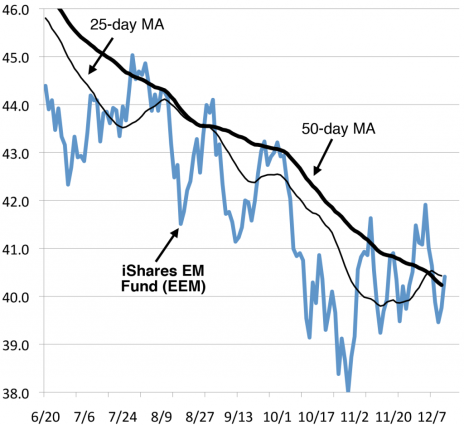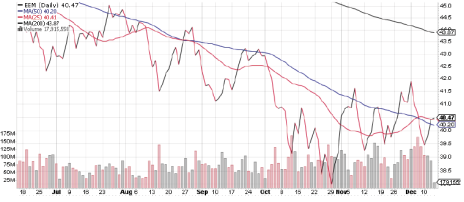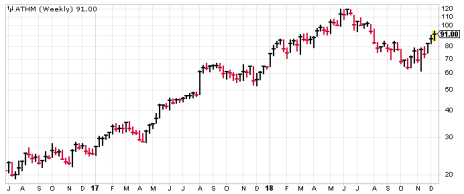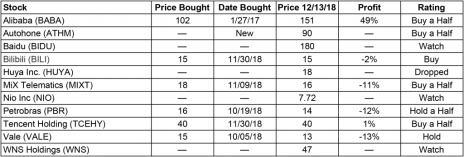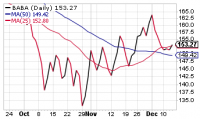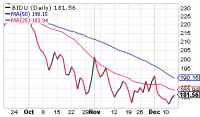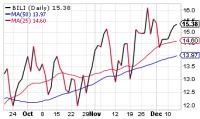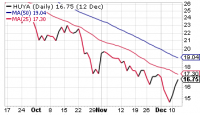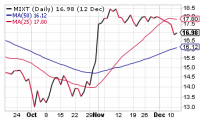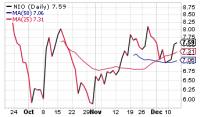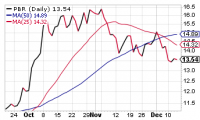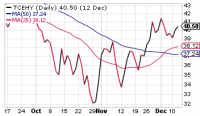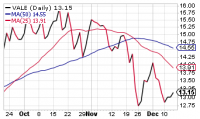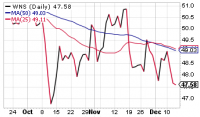On the one hand, emerging market stocks are extending their bottom-building structure. On the other hand, there aren’t many stocks making huge, “buy me!” runs. But on balance, the news is hopeful, as the October low for EM stocks is proving durable despite continuing trade-war talks and Brexit suspense. There are plenty of hopeful signs, but they haven’t revealed a change of heart on investors part. Read on for some good news and the return of an old friend to the portfolio.
Cabot Emerging Markets Investor 674
[premium_html_toc post_id="166208"]
Cabot Emerging Markets Timer
The Emerging Markets Timer is our disciplined method for staying on the right side of the emerging markets. The Timer is bullish when the index is above the lower of its two moving averages and that moving average is trending up.
Our Emerging Markets Timer is currently sitting in no man’s land, bobbing above and below its moving averages as it tries to carve out a sustainable low. While not positive, the recent action is certainly an improvement from the action of most of this year—the iShares EM Fund (EEM) remains solidly above its late-October low, though any push above its moving averages has brought in sellers so far.
This sort of hesitant trading isn’t unusual after a prolonged decline and is a reason we went slow on the buy side when we saw a green light from the Timer last month. It’s still not a time for a big buying spree, but the longer EM stocks can hold up above their lows, the greater the chance they push higher.
Tolerating Ambiguity
Bull markets are easy to deal with; you identify the best stocks in your investing universe and you shove your chips onto the table.
Surprisingly, bear markets are also easy, if not as enjoyable. You cut your buying to a minimum, tighten your loss limits and sit with your portfolio heavily in cash. And you wait.
The really tough markets to deal with are those that are heading sideways, either topping out in the transition from bullish to bearish, bottoming after a correction or just dithering along with no particular direction.
Emerging markets look like they’re building a bottom after a correction that began in January and shaved a little over 27% off the iShares Emerging Markets Fund (EEM) through its low point in late October. But the bottoming process really began earlier in October when EEM bounced briefly at 39, a level that again provided support in November after the last-gasp low was reached on October 29.
Here’s how EEM has acted going back to near its top in June. And pay special attention to the 200-day moving average, which is that descending black diagonal line that’s completely out of touch with the ETF’s recent movement. EEM fell below that line in June, and getting back there will be a huge milestone.
Corrections are like the progress we make every December to the Winter Solstice on the 21st: Things can’t start to get lighter until they’re as dark as possible. And things have been plenty dark in emerging market stocks. The duration and scale of the bear phase we’ve gone through has been sufficient to punish and discourage any investors who were foolish enough to stay fully invested through the whole process.
So, if you’re feeling bad about how long EM stocks have been tanking, just remember that the real bottom in the market will happen when the maximum number of investors are similarly disheartened. And they didn’t have your advantage of sitting heavily in cash!
Besides the possible bottoming process that we’re in (and which can only be confirmed in retrospect), there’s been another ray of hope for EM investors. And that’s the recent IPO of Tencent Music Entertainment Group (TME). The company raised $1.1 billion, which ranks with the top IPOs of the year.
Tencent Music is built pretty much on the Spotify model, with 655 million mobile monthly active users for its online music service, although only 25 million of those users are paying customers. (By contrast, Spotify has 191 million MAUs, but almost half are paying.)
Also by contrast, Tencent Music is profitable (something that has evaded Spotify), with users paying to send gifts to performers and huge support for its karaoke app.
And it’s not just TME—recent new issues like Pinduoduo (PDD) and Nio Inc. (NIO) have very intriguing, growth-oriented stories and are building solid post-IPO launching pads, despite the tough environment. Some other IPOs are heading lower, but it’s a plus to see some new blood (and new potential leadership).
For this issue’s stock, we’re returning to a stock that we exited profitably earlier this year. After a sizable pullback with the market, it’s back on an upward path.
Featured Stock
Vroom!
AutoHome (ATHM)
When times are tough, it’s good to have friends. And when the market is tough, it’s good to have stocks that are old friends that you can return to with confidence.
In today’s issue the Old Friend that we’re revisiting is AutoHome (ATHM), the premier online automobile shopping site in China.
Despite the pressures of the trade war, the slowdown in the Chinese economy and several months of declining sales, there’s no mistaking the importance of the Chinese automobile market. Chinese consumers are very sensitive to economic news, which accounts for the slowdown. Even so, auto sales during the first half of 2018 totaled 13.7 million vehicles, with another 6.3 million sales in Q3 and a projected 28.6 million sales for the year. Government incentives are shifting the sales mix toward smaller and low-emission vehicles, but that’s still a huge honking market. By contrast, U.S. auto sales of new vehicles is forecast to reach 16.7 million this year.
It’s hard to overestimate AutoHome’s position as the most important source of information, pictures and specifications on new cars, the prime link between dealers and their new and existing customers and the top connection between insurers and new owners. The company helps buyers with comparison shopping on brands, makes and models, prices and financing, licensing and insurance and navigating the twisty path of bureaucratic approvals.
All of this engagement gives AutoHome a dedicated and well qualified group of site visitors that it can use to attract advertising. And users who turn into buyers of cars and services also generate fees and commissions. After slowing to just 5% in 2017 (with a 7% dip in Q4 taking a bite out of the year’s results), AutoHome’s revenue growth has revived, with revenue up 22% in Q2 and 18% in Q3, with EPS growth of 32% and 50%, respectively, reinforcing the company’s potential. The company has averaged over 40% after-tax profit margins over the last four quarters.
One big reason AutoHome is back in favor with investors is the company’s Q3 earnings report on November 12. The company showed revenue of $275 million (up 18% from Q3 2017) and earnings of 90 cents per share, an increase of 50%. Both of those readings were well ahead of analysts’ estimates, but the stock fell slightly (from 67 to 64) on the day they were released. The real reaction started on November 13, when ATHM jumped to 71, then kept advancing. The rally that started in mid-November has now run all the way to above 90, and isn’t showing signs of stopping.
Even more important than the sheer numbers, the stock has finally climbed above its 200-day moving average, which is a potent technical barrier. (ATHM fell below the 200-day in the middle of August.
The bigger picture for ATHM is that it was a huge winner from the middle of 2016 to the middle of 2018, roaring from 19.3 to 120 during that stretch. But that high corresponded almost exactly with the top of the Golden Dragon China ETF (PGJ), which tracks all Chinese ADRs. As PGJ was falling from 51 to 32 (in late October), ATHM was dropping from 120 in June to 64 on October 19. (We’ve been talking about the reasons for the excessive aversion investors have shown to EM stocks over the second half of 2018, so we won’t belabor that point here.)
But the rebound in ATHM has been energetic and consistent, with just one instance of a pullback that lasted more than one day. And institutional support for ATHM has dipped only slightly from last quarter’s figure. ATHM trades at a 22 forward P/E and short interest has fallen for three straight months.
We know that adding AutoHome to the portfolio along with NIO Inc., which we put on the watch list in the November 29 issue, represents a bit of an overweight to the online automobile market in China. But where NIO is a very young (and fairly speculative) stock that’s trading sideways and well under 10, ATHM is a known quantity, highly liquid and is in a robust uptrend.
With the Cabot Emerging Markets Timer flashing neither a green nor a red light, we’ll recommend taking a half position in ATHM. BUY A HALF.
Autohome (ATHM)
CEC Plaza, Tower B
10th Floor 3 Dan Ling Street Haidian District
Beijing 100080
China
http://www.autohome.com.cn
Model Portfolio
Invested 45% Cash 55%
Updates
The nascent buy signal from the Emerging Markets Timer has fizzled out a bit, but we’re still mostly encouraged by the overall action—EM stocks hit their lows in late October, held solidly above those lows even during last week’s sharp dip and some stocks are perking up.
As we mentioned on page 1, it’s not a time for a big buying spree, and recent volatility is why we advise stepping in slowly when we get a market timing buy signal following a big decline. But, net-net, the action of the past couple of months has been a solid bottoming effort.
Among our stocks, there are plenty of good and a couple of iffy situations, but overall, we have no changes in tonight’s issue.
Alibaba (BABA) dipped last week, but like the overall EM market, remains well above its late-October lows (130 back then, 147 low last week) as investors look down the road toward reaccelerating earnings growth next year. It got lost in the tsunami of China trade news, but we think the company’s move to open its first European hub (in Belgium) could be a big deal. We’re OK buying a half position here if you don’t own any BABA. BUY A HALF.
Baidu (BIDU) actually nosed out to a new price low a couple of days ago, which isn’t the kind of relative strength we prefer to see. As we’ve written before, sometimes stocks take a little while to get going, and BIDU does have solid support in the 175-180 area, so we’re OK keeping it on the watch list. But should the market get going and BIDU keep lagging (maybe because of its mundane earnings outlook for next year), or if BIDU plunges through support, we’ll likely remove it from coverage. WATCH.
Bilibili (BILI) continues to act like it wants to head higher once the market gets moving—there is a little resistance around 16, but the stock has been etching higher lows for months. Fundamentally, analysts see revenues surging 56% next year (likely conservative), and the firm just bought some major assets from NetEase Comics, one of the China’s largest online comic platforms, boosting Bilibili’s content. We’ll stay on Buy. BUY.
Huya Inc. (HUYA) has bounced in recent days, but this comes after another round of big-volume selling to new lows. We’ll keep a distant eye on it, but the stock isn’t positioned to be a leader of any advance that kicks into gear during the next few weeks. DROP.
MiX Telematics (MIXT) has faded a bit in the short-term, but the story here is still the same—since its sharp, earnings-induced rally at the end of October and early November, the stock has held onto the vast majority of those gains, and looks poised to continue higher when the market rights itself. We don’t see MIXT as a rocket ship, but a steady grower that could emerge from a multi-month base and be a solid anchor in the portfolio. BUY A HALF.
NIO Inc. (NIO) fell to 6 in early October and again later that month, but last week’s dip brought it only down to 7 (a bit below), which is a nice show of resilience. It’s a speculative outfit, but this has all the makings of a powerful glamour stock—it’s liquid (trades north of $100 million per day in volume), has set up a nice post-IPO base and has massive projected growth ($2.4 billion in revenue next year, up 300%). A decisive break above 8.5 or so along with a market uptrend would be very enticing. WATCH.
Petrobras (PBR) has slipped to new correction lows in recent days, but we’re still going to give our half position a chance since the action is somewhat resilient compared to the horror show that is the energy sector. Our leash isn’t limitless, but over time we think the firm’s transformation and divestiture process can lead to a sustained run. We’re holding our half position for now. HOLD A HALF.
Tencent (TCEHY) IPO’d its music division yesterday, and while the pricing wasn’t as high as hoped for, Tencent Music (symbol TME, 57% of which is still owned by Tencent) is still valued around $20 billion. As for TCEHY, the stock is looking resilient, with lows near 32 in October, 34 in October and 38 this month. We’re still OK taking a nibble here or down a point or two if you don’t own any and have plenty of cash on the sideline. BUY A HALF.
Vale (VALE) is still hovering near its lows, but holding support in the 13 (give or take) area. We’ll stay on Hold, as most of this decline has been due to fears that China’s purchases of iron ore are set to skid (causing prices to skid, too). We’ll hold but this one is on a very tight leash. HOLD.
WNS Holdings (WNS) isn’t inspiring, as it wobbles back toward its correction lows. Similar to BIDU, we’re OK watching it here, but we want our watch list to be full of resilient potential leaders, not stocks that are barely holding on. WATCH.
[premium_html_footer]
Send questions or comments to paul@cabotwealth.com.
Cabot Emerging Markets Investor • 176 North Street, Salem, MA 01970 • www.cabotwealth.com
All Cabot Emerging Markets Investor buy and sell recommendations are made in issues or updates and posted on the Cabot subscribers’ website. Sell recommendations may also be sent to subscribers as special alerts via email. To calculate the performance of the hypothetical portfolio, Cabot “buys” and “sells” at the midpoint of the high and low prices of the stock on the day following the recommendation. Cabot’s policy is to sell any stock that shows a loss of 20% in a bull market (15% in a bear market) from our original buy price, calculated using the current closing (not intra-day) price. Subscribers should apply loss limits based on their own personal purchase prices.
THE NEXT CABOT EMERGING MARKETS INVESTOR ISSUE IS SCHEDULED FOR December 27, 2018
We appreciate your feedback on this issue. Follow the link below to complete our subscriber satisfaction survey: Go to: www.surveymonkey.com/chinasurvey
Cabot Emerging Markets Investor is published by Cabot Wealth Network, an independent publisher of investment advice since 1970. Neither Cabot Wealth Network, nor our employees, are compensated in any way by the companies whose stocks we recommend. Sources of information are believed to be reliable, but they are in no way guaranteed to be complete or without error. Recommendations, opinions or suggestions are given with the understanding that subscribers acting on information assume all risks involved. © Cabot Wealth Network 2018. Copying and/or electronic transmission of this report is a violation of the copyright law. For the protection of our subscribers, if copyright laws are violated, the subscription will be terminated. To subscribe or for information on our privacy policy, visit www.cabotwealth.com, write to support@cabotwealth.com or call 978-745-5532.
[/premium_html_footer]


